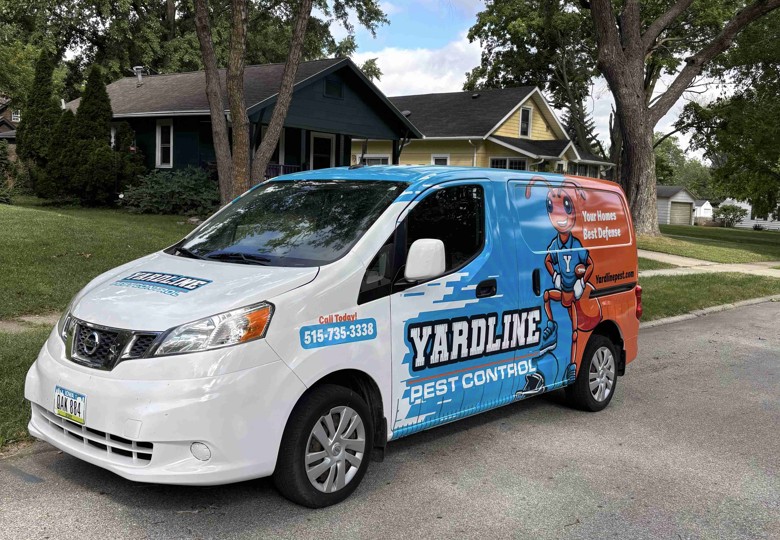How to Use PPC for Lawn Care Businesses

Pay-per-click advertising, or PPC advertising, plays a powerful role in lawn care and landscaping companies’ overall digital marketing strategy. PPC ensures your ads appear in the right place at the right time to help you book more appointments.
However, the power of PPC goes beyond generating leads. PPC also supports brand awareness, increases website traffic, and delivers trackable results that help you understand your customers more deeply.
Pay-Per-Click Explained
Pay-per-click (PPC) is online advertising that charges you only when someone clicks your ad. It’s an effective way to generate qualified leads. When new customers search for lawn care and landscaping services online, your ad appears in their results.
Google Ads (formerly Google AdWords) and Microsoft Ads (formerly Bing Ads) are the two most common PPC platforms. They allow you to create targeted ads at the top of search engine results pages (SERPs). Successful PPC ad campaigns combine:
Relevant keywords
Compelling ad copy
Competitive bidding strategy
PPC platforms track your ad performance to show you what’s working and what’s not, enabling you to make changes that maximize your ad spend.
The most important PPC terms to know when starting include:
Keywords: These are the words or phrases people use to search online, such as “lawn mowing service.”
Ad groups: These are groups of related keywords, such as “lawn mowing service,” “lawn mowing service near me,” and “lawn mowing Bakersfield.”
Bid: This is the maximum amount of money you will pay when someone clicks your ad.
This basic understanding of PPC gives you everything you need to create effective PPC campaigns.
Lawn Care and Landscaping PPC Best Practices
As you venture toward creating your first PPC campaigns, keep these seven best practices in mind.
Set a realistic budget. How much money you should spend on PPC varies depending on location and competition. Choose a simple number, such as $100 per day, and adjust based on results.
Pick relevant keywords. Relevant keywords align what your business offers with what your target audience is likely looking for, such as “tree pruning near me.” Use a keyword research tool, such as Keyword Planner in Google Ads, to find good keywords.
Write compelling ad copy. Your ad copy should be clear, concise, and persuasive. Include your target keyword, any promotions, and what distinguishes you from the competition. For instance, “Grub Control by Central Tennessee Lawn Experts. 50% Off First Treatment.”
Bid competitively. Your maximum bid amount determines how high your ad will appear on SERPs. Like with your ad budget, it takes some experimenting to find what bid will drive the most clicks at a reasonable cost.
Use ad extensions. Ad extensions are additional pieces of information you can include in your ads. Common examples include your business’s phone number, address, and website. They make your ads more informative and appealing to potential customers.
Monitor ad campaign performance. The more you track what's working and what's not, the more you can optimize your ad campaigns. Use your PPC platform to track metrics, such as impressions (number of times your ad was shown), clicks (number of times your ad was clicked), and conversions (number of times someone took a desired action after clicking, such as submitting a form).
Optimize and test regularly. Try different ad copy, keywords, and bids to see what improves campaign performance. For example, if you just won the best landscaping provider in your city, see how highlighting that impacts your ads.
Following these PPC campaign best practices, especially the last two, will turn your PPC advertising into a lead-generation machine. But above all else, what matters most is understanding your target audience.
Who Is the Audience for Lawn Care PPC?
The more you understand your target audience, the more effective your marketing and advertising becomes. In this case of lawn care and landscaping PPC, your target audience starts with homeowners and businesses with turf to maintain.
From there, segment your audience based on their unique needs. This segmentation enables you to create specific ads for specific groups. That might look like:
Homeowners who do most of their own maintenance: This group will respond better to ads for specialty services that are difficult to do themselves, like aerating and verticutting, versus routine services like mowing and edging.
Homeowners who want someone else to do their maintenance: This group may need more time to take care of their kids or work long hours. For them, routine maintenance such as mowing, fertilizing, and weeding is just what they’re looking for.
Homeowners who want to maximize curb appeal: This group includes people who plan to sell their homes in the next few years. It may also include people who own rentals or take lots of pride in their home’s appearance.
Homeowners who are concerned about their environmental impact: This group might be battling weeds and pests, but they’d prefer to improve lawn health instead of using pesticides. Ads emphasizing organic and natural lawn care will more likely appeal to them.
Additionally, demographics should factor into your PPC ads. Some basic demographics to start with include:
Interests: Homeowners interested in gardening, landscaping, and home improvement in general will be more receptive to lawn care ads.
Location: Homeowners and businesses in affluent zip codes will likely have the budget and desire to afford lawn care.
Age: Homeowners in their 40s and 50s are more likely to afford lawn care than young homeowners just starting.
As the audience segmentation examples above show, effective PPC campaigns flow from understanding your potential customers as thoroughly as possible.
How to Get Started With Lawn Care PPC
Lawn care PPC breaks down into four steps: defining your goals, researching keywords, creating ad campaigns, and optimizing landing pages.
After that, it’s all about measuring results and applying learnings to your next campaigns.
Step 1: Define Your PPC goals and objectives
Campaigns that get results start with clear, specific goals. Many digital marketers use a framework called SMART, which stands for:
Specific: What exactly do you want to achieve?
Measurable: How will you track progress and measure success?
Achievable: Are your potential goals too easy? Too hard?
Relevant: How well do your goals align with current business priorities?
Time-bound: What’s the deadline for achieving your goals?
The following sample lawn care PPC goals all align with the SMART framework:
Increase website traffic by 20% by the end of next quarter.
Generate 100 new leads per month.
Promote a new overseeding service to homeowners in the suburbs.
Your PPC goals will naturally change depending on the needs of your business. A new lawn care company may benefit most from generating new leads. A more mature business may benefit more from increasing website traffic and add-on bookings.
Step 2: Conduct Keyword Research for Lawn Care PPC
Keyword research means identifying the words and phrases your target audience uses to search for lawn care services. Finding the right keywords for your PPC ads is equal parts art and science. It requires ongoing experimentation to find what resonates with your audience the most.
But when done right, keyword research yields results quickly. Research happens over three phases:
Finding industry-specific keywords: That is, keywords that match the specific lawn care services you offer, such as "commercial lawn care," "weed control," and "dethatching."
Studying keyword data: Keyword tools deepen the context around your potential keywords by providing data points such as monthly search volume. They also suggest related keywords that may need to be added to your radar. Popular keyword tools include Google Keyword Planner, SEMrush, and Ahrefs.
Analyzing competitiveness: Competitiveness in PPC refers to cost. If your competitors bid high on specific keywords, it may make sense to look at alternatives. For example, keywords with less traffic but higher specificity usually result in higher conversion rates.
When starting out, it’s okay to let your PPC platform guide your keyword choices. As you gain experience and better understand your local advertising space, you can start testing your hypotheses about which keywords will deliver the best ROI.
Step 3: Create Effective PPC Ad Campaigns
With your keywords identified, it’s time to build ad campaigns in your PPC platform. The process typically looks something like this.
Write engaging ad copy: Grab attention with short, strong headlines that include your target keyword. Focus on one key selling point, then use the content on your landing page to flesh things out in more detail.
Use ad extensions: Ad extensions enhance your ad content by adding valuable information, such as call extensions, images, and lead forms. Google Ads offers many types of ad assets for free.
Build relevant landing pages: Your landing page is the page customers land on after clicking your ad. Continue the conversation from your ad copy with appropriate, specific details that add value. Read more on landing pages in the next section.
Optimize ad targeting settings: Select the most relevant keywords and demographic information based on your desired audience. Select negative keywords — that is, keywords you purposefully want to exclude — so you avoid spending money on clicks unlikely to convert into customers.
At this point, it’s worth taking a deeper look at creating and optimizing your landing pages.
Step 4: Optimize Landing Pages for Conversion
To convert clickers into leads, you must create landing pages that inspire readers to take action. The elements of a well-optimized landing page include:
Compelling content: Your landing page should inform and persuade. Establish the reader's pain (bare spots on lawn, dusty soil), then show how you solve the problem (curative and preventative grub treatments).
Clear call-to-action (CTA): A strong CTA is short and direct. It tells visitors exactly what you want them to do, such as “Contact us” or “See pricing.”
Mobile responsiveness: Most online searches happen on smartphones and tablets. That makes mobile responsiveness a necessity for a good customer experience. Responsive design automatically makes your web pages look good and function properly, no matter what device customers use.
A/B testing is the go-to method for continually optimizing landing pages. A/B testing means testing two versions of your landing pages — an A and B version — to see which performs best.
Test one element at a time, such as two different headlines. Otherwise your data starts to get messy. Plenty of tools help you run A/B tests, such as Google Optimize.
Other Types of Digital Marketing to Consider
PPC alone goes only so far. After all, no company has an unlimited ad budget. Ideally, PPC combines with other strategies to create a robust lawn care digital marketing operation.
The following marketing strategies all counterbalance PPC. As each one ramps up into a reliable lead-generation channel, you can spend less on paid advertising. For instance, SEO and PPC are a classic combination because they rely on similar keywords.
(Local) SEO
Local lawn care SEO — aka local search engine optimization — helps you reach potential customers in your service area by optimizing your website and online presence for local searches. Key tactics include:
Optimize your Google My Business listing and your listings on other online directories such as Yelp, Better Business Bureau, and Yellow Pages.
Use relevant keywords throughout your website and online content to appear higher in organic search results.
Create location-specific landing pages, such as one for each office location.
Backlinks are also a vital ranking factor in local SEO. Backlinks are links on other businesses’ websites that link back to yours. Innovative ways to earn them include creating high-quality content such as blogs and videos and collaborating with local companies on webinars and other online and offline events.
Social Media Marketing
Social media marketing builds brand awareness and generates leads by engaging customers in ways other types of marketing can’t. For instance, Instagram and YouTube let you visualize your services through images and video in ways your blog can’t.
These social media tactics help lawn care and landscaping businesses build loyal followings:
Create profiles on popular social media platforms and tailor your content to each.
Share high-quality content that’s relevant to your audience's interests, such as sharing fall lawn care tips in the summer.
Use social media ads to broaden your reach.
Respond to comments and questions from customers promptly.
Like with your PPC campaigns and other marketing efforts, track the results of your social media marketing to identify what tactics drive the most value, then optimize from there.
Email marketing
Email marketing gives you a direct pipeline to customers’ inboxes. That makes it a powerful channel for nurturing leads, promoting your services, and driving repeat business. Successful email marketing involves:
Collecting email addresses from potential customers through tactics such as embedding opt-in forms throughout your website.
Segmenting your email list by customer type so you can customize your offers and messaging.
Sending regular emails with informative, engaging, and relevant content.
Using email marketing automation to send triggered emails, such as a welcome email when customers sign up.
Tracking email marketing results such as open rates, click-through rates, and unsubscribe rates to optimize future sends.
Before venturing into email marketing, understand regulations such as the CAN-SPAM Act. Doing so will help you stay compliant and avoid costly violations.
Online review management
Online reviews — and how you interact with them — strongly impact your business reputation. Proper online review management builds trust and attracts new customers. Positive reviews act like referrals, and negative reviews showcase your professionalism when addressed promptly and respectfully.
Best practices in online review management include:
Claim and monitor your Google My Business profile and your business listings on other online directories.
Respond to all reviews, positive and negative, promptly and professionally. Not appreciating a positive review can look as bad as not addressing a negative review.
Address negative reviews quickly and effectively.
Encourage customers to leave reviews on relevant websites, from your business listings to social media pages.
Following these best practices will show potential customers you’re a forthright business that will deal with them fairly.
Need Help With Your Lawn Care PPC?
Only some lawn care businesses have the bandwidth to learn PPC. If that’s holding you back from growing your lawn care business, let FieldRoutes, a ServiceTitan company, handle your paid advertising.
As the creators of award-winning lawn care and landscaping software, we understand your competition and how to beat it.
See how with a free demo.





